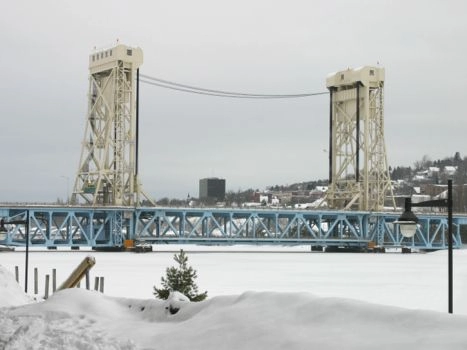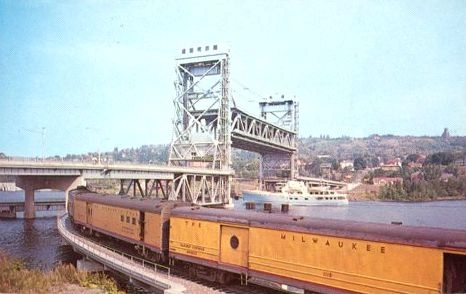Portage Canal Bridge, Houghton, MI (MR-CR) #3 1959 ♦ ♣
- Details
- Hits: 7210
 Location: Portage Canal Bridge, Houghton, MI - (MR-CR) #3 1959
Location: Portage Canal Bridge, Houghton, MI - (MR-CR) #3 1959
This is a lift bridge which crosses the Portage Canal in downtown Houghton/Hancock. The current bridge is only used for vehicle traffic. The bridge has two levels, allowing rail traffic on the lower section and vehicle traffic on the upper section. During it's heyday, the lower section was raised to the road level for cars, allowing low clearance boat traffic to clear without raising the bridge completely up.
There have been a number of bridges over the Canal at this point during history, including swing bridges. Many were damaged because of weather and ice conditions. The span was originally used by the Mineral Range, followed by the Duluth, South Shore and Atlantic, the Copper Range Railroad and even Milwaukee Road passenger trains bound for Calumet. The last user was the Soo Line before the rails were removed.
Photo info: Above - December, 2004 looking west in a winter view. [Dale Berry]. Right - A postcard view from the Houghton side, with a Milwaukee Road passenger train heading on the lower level to Hancock and beyond to Calumet. 1962.
Notes

The current Houghton-Hancock Bridge over Portage Lake was constructed in 1959. This vertical lift bridge replaced a 1905 steel swing bridge which had in turn replaced an earlier wooden swing bridge. The new bridge was constructed by the State of Michigan with the two railroads which used the bridge (the DSS&A and the Copper Range) sharing in the costs which amounted to over $13 million. The chief engineer was Martin McGrath, while George Jacobson was the bridge engineer. The Al Johnson Construction Company was the general contractor, the American Bridge Company erected the superstructure, and the Bethlehem Steel Company supplied the structural steel. The bridge has an overall length of 1,310' with a lift span 260' long, and twin steel towers 180' high. When fully raised, the lift span provides a clearance of 104' for shipping on Portage Lake, part of the Keweenaw Waterway it is a two-level bridge, with four highway lanes on the upper segment and a railroad track on the lower level. [UPM]
Time Line
1956. The State Highway Department expects to start the construction of a new US-41 bridge crossing Portage ship canal between Houghton and Hancock by fall of this year. Detailed plans for the new bridge, which will have a vertical lift for the center span, are well advanced. Bids will be taken by October 1. The structure will be completed in 1958. The new bridge will be built adjacent to and on the west side of the present bridge which will continue to carry traffic until the new bridge is ready for service. The old bridge will then be dismantled. This will be the first vertical lift bridge on the state trunkline system and will carry railroad, highway and pedestrian traffic all at one time. It will have two levels, the lower for trains of the DSS&A and Copper Range railroads, and the upper for vehicular and pedestrian traffic. The most unique feature of the new bridge's design will be the arrangement whereby small craft will be able to pass under one bridge without halting vehicular traffic.; When trains are not using the lower track level, it will be raised up to the level of vehicular traffic which will then travel on the train deck. This will enable small boats to pass under the bridge without halting vehicle traffic. When trains wish to cross the canal, the center span will be lowered so that the train tracks will fall in line with the tracks on the other sections of the bridge.
Overall length of the new bridge will be 1,310 feet, consisting of the 253.5 foot center lift span, two lower spans each 120 feet long and flanking the center lift span, and eight deck girder spans totaling 800 feet in length, four of them on each end of the bridge.
The present bridge between Houghton and Hancock is entirely inadequate for present traffic on US-41 across Portage canal. The center span is a swing type which operates very slowly. Inadequacy of the present structure has resulted in the Corps of Engineers, U.S. War Department, ordering the Highway Department to replace the present span. [EDP-1956-0723]
1959. June 10. Fred Clement's present job with the DSS&A railway doesn't require much effort. All he has to do is turn a switch twice a day. Because he has next to top seniority on the Houghton division of the South Shore, Clement, 62, took over the job April 27 when work started on a new lift bridge linking Houghton with the north side of Portage Lake. The Copper Range railroad's approach to the bridge is being removed and the South Shore line has to provide a pilot for a Copper Range train on the South Shore tracks. Since Aril, Clement has been called from his home in Houghton each morning to turn a switch. He repeats the chore in the afternoon. This will go on until the middle of November when an $11 million bridge replacing an old drawbridge built in 1905 will be completed. [LSJ-1959-0610]
1959. November 4. The new lift bridge is opened, replacing the old swing bridge built in 1906. [EDP-1959-1031]
1959. November 19. The Portage Canal Drawbridge, which had bottled up a Keweenaw Peninsula short-cut across Lake Superior since Monday, was back in operation today. The span, literally frozen shut, was steamed out Wednesday by Copper Range railroad workers. Heavy snowfall which began to melt in above-freezing temperatures and seeped into crevices and working joints was frozen solid as temperatures plunged into below-zero levels Monday. Two ships tied up rather than return to Lake Superior and face the rough rounding of Keweenaw Point in gale-force winds. [SJH-1959-1119]
Video
- Keweenaw Crossing, Michigan's Elevator Bridge - A history of the highway/railroad crossing of the Portage Canal (1950's)
Bibliography
The following sources are utilized in this website. [SOURCE-YEAR-MMDD-PG]:
- [AAB| = All Aboard!, by Willis Dunbar, Eerdmans Publishing, Grand Rapids ©1969.
- [AAN] = Alpena Argus newspaper.
- [AARQJ] = American Association of Railroads Quiz Jr. pamphlet. © 1956
- [AATHA] = Ann Arbor Railroad Technical and Historical Association newsletter "The Double A"
- [AB] = Information provided at Michigan History Conference from Andrew Bailey, Port Huron, MI

